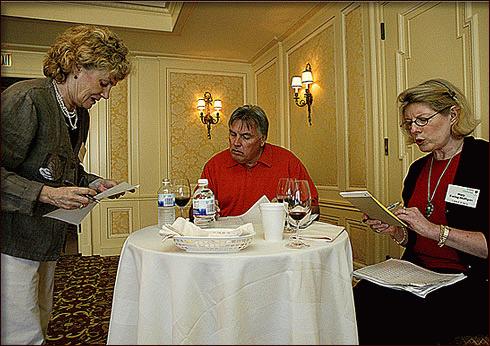
Immersed as I am in the first (Monterey) of the three big wine competitions I run, I’ve been thinking lately about what makes a good wine judge.
Ultimately, it comes down to you. You are the judge that really counts.
Imagine, if you will, that you are entertaining a large crowd over dinner, and that everyone around the table enjoys a glass of wine, or two, with a meal. You open several different wines and spread them around.
Conversation breaks out, plates are passed, bottles are passed and, at the end of the night, a few bottles have been drained and a few appear to be relatively untouched. Whether you realized it at the time, or not, your wine selection had been judged. The winners? The empty bottles, of course.
It is no different at a commercial wine competition. I instruct the judges to find the empty bottles; the bottles that will prove most satisfying at the end of the day.
The only thing that separates you, a wine enthusiast, from a professional wine judge is training and practice. The prospect of tasting 100 or more wines in a single day would prove daunting for most. Wine judges are primarily professionals in the wine business, including winemakers, vintners, sommeliers, and sales and marketing folks, and they have made a career of tasting multiple wines in an analytical setting.
They generally taste each wine ‘blind’ so that no one is influenced by label recognition or price, and historically the percentage of medals awarded falls within a narrow window that varies little from one wine competition to the next. Proving, I suppose, that evaluations are relatively consistent from competition to competition.
Most competitions choose their medal-winners by a panel vote, a structure I utilize for the Monterey and San Diego wine competitions (but not the unique Critics Challenge, which bases its awards on the individual assessments of renowned wine critics).
I like at least one member of each panel to be either a winemaker or a ‘super’ taster, such as a highly regarded sommelier or wine merchant. This person is primarily on the lookout for flaws that should either disqualify a wine or mute its achievement.
The other judges are looking for aesthetically pleasing qualities that merit recognition in the form of either a bronze, silver or gold medal. When it works the way it is supposed to, a good judging panel reaches a consensus that weeds out flawed wines and rewards wines that will deliver the goods to the ultimate benefactor of wine competitions – the consumer.
It is often said that a winemaker is looking for what’s wrong with a wine, while the rest of us are focused on what we like. Between those two perspectives, good results will flow.
Of course, when you peruse the medal-winners, only you can decide which wines you will purchase. You are the ultimate judge. In the end, the only judge that matters.
Results of the Monterey Wine Competition (March 1-2) following the judging may be found at SalinasValleyFair.com. The San Diego International Wine Competition (April 19-20) results will be posted at SDIWC.com shortly after the judging, and Critics Challenge (May 24-25) winners can be found at CriticsChallenge.com.
PHOTO: Judges Marguerite Thomas, Robert Whitley and Mary Ewing-Mulligan consult during a recent Critics Challenge.
8
